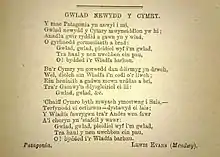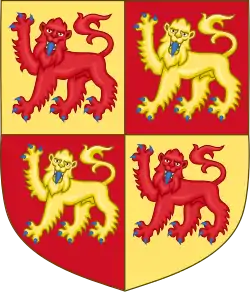Hen Wlad Fy Nhadau
"Hen Wlad Fy Nhadau" (Welsh pronunciation: [heːn wlɑːd və n̥adaɪ̯]) is the national anthem of Wales.[1] The title, taken from the first words of the song, means "Old Land of My Fathers" in Welsh, usually rendered in English as simply "Land of My Fathers". The words were written by Evan James and the tune composed by his son, James James, both residents of Pontypridd, Glamorgan, in January 1856.[1][2] The earliest written copy survives and is part of the collections of the National Library of Wales.[2]
| English: Old Land of My Fathers | |
|---|---|
.jpg.webp) The earliest version of "Hen Wlad Fy Nhadau" in the hand of the composer, James James, 1856 | |
National anthem of | |
| Lyrics | Evan James, 1856 |
| Music | James James, 1856 |
| Audio sample | |
| |
Origins
Glan Rhondda (Banks of the Rhondda), as it was known when it was composed, was first performed in the vestry of the original Capel Tabor, Maesteg (which later became a working men's club), in either January or February 1856, by Elizabeth John from Pontypridd, and it soon became popular in the locality.[2]
James James, the composer, was a harpist who played his instrument in the public house which he ran, for the purpose of dancing.[2] The song was originally intended to be performed in 6/8 time, but had to be slowed down to its present tempo when it began to be sung by large crowds.
Popularity
The popularity of the song increased after the Llangollen festival of 1858. Thomas Llewelyn of Aberdare won a competition for an unpublished collection of Welsh airs with a collection that included Glan Rhondda. The adjudicator of the competition, "Owain Alaw" (John Owen, 1821–83) asked for permission to include Glan Rhondda in his publication, Gems of Welsh melody (1860–64). This volume gave Glan Rhondda its more famous title, "Hen Wlad Fy Nhadau", and was sold in large quantities and ensured the popularity of the anthem across the whole of Wales.[2]
At the Bangor Eisteddfod of 1874 "Hen Wlad Fy Nhadau" gained further popularity when it was sung by Robert Rees ("Eos Morlais"), one of the leading Welsh soloists of his day.[3] It was increasingly sung at patriotic gatherings and gradually it developed into a national anthem.[2]
"Hen Wlad Fy Nhadau" was also one of the first Welsh-language songs recorded when Madge Breese sang it on 11 March 1899, for the Gramophone Company, as part of the first recording in the Welsh language.[2][4]
In 1905, "Hen Wlad Fy Nhadau" became the first national anthem to be sung at the start of a sporting event.[5][6] Although crowds singing anthems during matches was commonplace, there was no precedent for the anthem to be sung before a game commenced in any sport.[n 1] The Welsh national rugby team were playing host to the first touring New Zealand team, who to that point were unbeaten. After Wales won the Triple Crown in the 1905 Home Nations Championship the match was dubbed the 'Game of the Century' by the press. The New Zealand team started every match with the Haka, and Welsh Rugby Union administrator Tom Williams, suggested that Wales player Teddy Morgan lead the crowd in the singing of the anthem as a response. After Morgan began singing, the crowd joined in,[8] and Wales became the first nation to sing a national anthem at the start of a sporting event.[9]
In 1978 as part of their album, also called Hen Wlad Fy Nhadau, Geraint Jarman a'r Cynganeddwyr recorded a version of the Welsh national anthem using electric guitars, inspired by Jimi Hendrix's rendition of the Star-Spangled Banner. Jarman's version, played by Welsh guitarist Tich Gwilym is one of the most famous modern versions of the song.[6]
Usage
Tradition has established "Hen Wlad Fy Nhadau" as an unofficial Welsh anthem[1] since 1905, when it was first sung by fans at rugby games, although the official anthem at the time was "God Bless the Prince of Wales". "Hen Wlad Fy Nhadau" slowly established itself as the more popular anthem over the next four decades, and was sung along with "God Bless the Prince of Wales" and "God Save the Queen" before sporting events until 1975, when sports officials decided that "Hen Wlad Fy Nhadau" should be sung alone. Like other British anthems, it has not been established as a national anthem by law, but it has been used as a national anthem at official governmental ceremonies, including the opening of the Welsh Assembly, and at receptions of the British monarchy since the 1970s.[2][6] It is recognised and used as an anthem at both national and local events in Wales.
"Imagine some 40,000 people singing their national anthem with all the fervour of which the Celtic heart is capable. It was the most impressive incident I have ever witnessed on a football field. It gave a semi-religious solemnity to this memorable contest, intensely thrilling, even awe-inspiring. It was a wonderful revelation of the serious spirit in which the Welsh take their football."
All Black captain Dave Gallaher's remark on experiencing the Welsh singing their anthem for the first time.[10]
Usually this will be the only anthem sung: only the first stanza and chorus are usually sung (and in the Welsh language). "God Save the Queen", the national anthem of the United Kingdom, is sometimes played alongside "Hen Wlad Fy Nhadau" during official events with a royal connection.[6]
The existence of a separate national anthem for Wales has not always been apparent to those from outside the country. In 1993 the newly appointed Secretary of State for Wales John Redwood was embarrassingly videotaped opening and closing his mouth during a communal singing of the national anthem, clearly ignorant of the words but unable to mime convincingly;[11] the pictures were frequently cited as evidence of his unsuitability for the post. According to John Major's autobiography, the first thing Redwood's successor William Hague said, on being appointed, was that he had better find someone to teach him the words. He found Ffion Jenkins, and later married her.[6]
"Hen Wlad Fy Nhadau" has been adapted to the anthems of Cornwall (Bro Goth agan Tasow), Brittany (Bro Gozh ma Zadoù),[11] and Y Wladfa (Gwlad Newydd y Cymry, see below). These adaptions share the same tune as "Hen Wlad Fy Nhadau" and have similar lyrics.
Lyrics
Mae hen wlad fy nhadau yn annwyl i mi,
Gwlad beirdd a chantorion, enwogion o fri;
Ei gwrol ryfelwyr, gwladgarwyr tra mad,
Dros ryddid collasant eu gwaed.
Gwlad!, GWLAD!, pleidiol wyf i'm gwlad.
Tra môr yn fur i'r bur hoff bau,
O bydded i'r hen iaith barhau.
Hen Gymru fynyddig, paradwys y bardd,
Pob dyffryn, pob clogwyn, i'm golwg sydd hardd;
Trwy deimlad gwladgarol, mor swynol yw si
Ei nentydd, afonydd, i fi.
Os treisiodd y gelyn fy ngwlad tan ei droed,
Mae hen iaith y Cymry mor fyw ag erioed,
Ni luddiwyd yr awen gan erchyll law brad,
Na thelyn berseiniol fy ngwlad.
Translations
|
Verse translation by A.P. Graves[12] O Land of my fathers, O land of my love,
|
Verse translation by W.S. Gwynn Williams[13] The land of my fathers is dear to me,
|
A more literal translation: The old land of my fathers is dear to me,
|
Cultural influence
The Welsh poet Dylan Thomas is often quoted as saying "The land of my fathers. My fathers can have it!" in reference to Wales. However, this is misleading, as it was a villainous character in one of Thomas' short stories that spoke this line.
Gwynfor Evans named his history of Wales Land of my fathers: 2,000 years of Welsh history. It was a translation of the Welsh original, Aros Mae.
The £1 coins minted in 1985, 1990, 1995 and 2000 with a Welsh emblem on the reverse, also bear the edge inscription PLEIDIOL WYF I'M GWLAD ("I am devoted to my country"), from the refrain of "Hen Wlad Fy Nhadau".[14] The new Royal Badge of Wales adopted in 2008 features this motto.
Gwlad Newydd y Cymry

A version of "Hen Wlad Fy Nhadau" was written by Lewis Evans, a migrant from Wales to Y Wladfa, a Welsh-speaking settlement in Patagonia, South America. The version penned by Evans is called Gwlad Newydd y Cymry (The New Country of the Welsh). Gwlad Newydd y Cymry is played to the same tune as "Hen Wlad Fy Nhadau".[15]
The lyrics to Gwlad Newydd y Cymry are as follows (note that the spelling is not consistent with modern Welsh):
LyricsY mae Patagonia yn annwyl i mi,
|
TranslationPatagonia is dear to me,
|
Footnotes
- In the United States, singing of patriotic songs before games was first observed in the years following the Civil War, with "The Star-Spangled Banner" occasionally being sung before baseball games. However, the song's pregame use did not become customary until the 1920s, and "The Star-Spangled Banner" did not become the official national anthem until 1931.[7]
References
- "Welsh National Anthem". wales.com. Welsh Government. 2014. Retrieved 24 May 2014.
- "Welsh anthem – The background to Hen Wlad Fy Nhadau". Wales history. BBC Cymru Wales. 1 December 2008. Retrieved 3 December 2010.
- "The History of the National Anthem". Rhondda Cynon Taf Library Services. UK. Archived from the original on 28 September 2011. Retrieved 27 December 2011.
- The first known recording of Hen Wlad fy Nhadau, UK: Gathering the Jewels, archived from the original on 9 December 2017, retrieved 5 January 2019.
- "Welsh national anthem". Wales.com website. Welsh Government. 2015. Archived from the original on 16 February 2015. Retrieved 24 March 2015.
- "The anthem in more recent years". Wales History. BBC. 1 December 2008. Retrieved 3 December 2010.
- Cyphers, Luke; Trex, Ethan (8 September 2011). "The song remains the same". ESPN The Magazine. Retrieved 10 April 2016.
- "School remembers Teddy's 1905 try". BBC. 4 February 2005. Retrieved 13 June 2010.
- "The 1905/06 'Originals'". NZ: Rugby museum. Archived from the original on 10 September 2012. Retrieved 13 June 2010.
- Hitt, Carolyn (17 February 2018). "Our national anthem is Wales' secret weapon and a 16th player on the pitch". WalesOnline.
- Davies, John; Jenkins, Nigel (2008). The Welsh Academy Encyclopaedia of Wales. Cardiff: University of Wales Press. p. 364. ISBN 978-0-7083-1953-6.
- Moffat, Alistair (12 August 2011). The Sea Kingdoms: The History of Celtic Britain and Ireland. Birlinn Limited. ISBN 9780857901163.
- "The Celtic Festival Goes to Wales" (PDF). The Cherry Creek Chorale. 11 March 2016.
- "Welsh National Anthem". Visit Wales website. Welsh Government. 2012. Retrieved 1 July 2012.
- Axtell, William. ""A song for a new Welsh nation": Patagonian Welsh national anthem discovered in 19th century pamphlet | Culture24". Culture24. Retrieved 14 April 2019.
Learn to read, pronounce, sing perform Welsh National Anthem; New App published by the National Library of Wales published. https://itunesconnect.apple.com/WebObjects/iTunesConnect.woa/ra/ng/app/908469898
External links
| Welsh Wikisource has original text related to this article: |
| Wikisource has original text related to this article: |
| Wikimedia Commons has media related to Hen Wlad Fy Nhadau. |
- Jones, Cantorion Colin, Learn the Welsh National Anthem the Easy Way (Google You tube) (video), The North Wales Male Chorus.
- Hen wlad fy nhadau (sheet music arranged for piano and voice), Cantorion.
- Côr Meibion Pontypridd, Hen wlad fy nhadau, Male choir, archived from the original on 14 July 2011.
- Hen wlad fy nhadau, UK: Welsh Icons, archived from the original (midi file and vocal video) on 1 June 2009.
- James, Sian, "Hen Wlad Fy Nhadau", You tube (video) (played on the Triple Harp and sung).
- Hen wlad fy nhadau (lyrics), UK: Welshpedia, archived from the original on 15 June 2011, retrieved 20 June 2010.
- Redwood, John, Hen Wlad Fy Nhadau, You Tube.
- Siôn T. Jobbins, The Welsh National Anthem: its story, its meaning (Y Lolfa, 2013)

